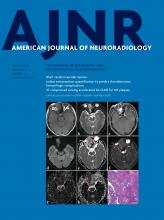Abstract
BACKGROUND AND PURPOSE: Although Diffeomorphic Anatomical Registration Through Exponentiated Lie Algebra (DARTEL) has been introduced as an alternative to conventional voxel-based morphometry, there are scant data available regarding the optimal image-processing settings. The aim of this study was to optimize image-processing and ROI settings for the diagnosis of Alzheimer disease using DARTEL.
MATERIALS AND METHODS: Between May 2002 and August 2014, we selected 158 patients with Alzheimer disease and 198 age-matched healthy subjects; 158 healthy subjects served as the control group against the patients with Alzheimer disease, and the remaining 40 served as the healthy data base. Structural MR images were obtained in all the participants and were processed using DARTEL-based voxel-based morphometry with a variety of settings. These included modulated or nonmodulated, nonsmoothed or smoothed settings with a 4-, 8-, 12-, 16-, or 20-mm kernel size. A z score was calculated for each ROI, and univariate and multivariate logistic regression analyses were performed to determine the optimal ROI settings for each dataset. The optimal settings were defined as those demonstrating the highest χ2 test statistics in the multivariate logistic regression analyses. Finally, using the optimal settings, we obtained receiver operating characteristic curves. The models were verified using 10-fold cross-validation.
RESULTS: The optimal settings were obtained using the hippocampus and precuneus as ROIs without modulation and smoothing. The average area under the curve was 0.845 (95% confidence interval, 0.788–0.902).
CONCLUSIONS: We recommend using the precuneus and hippocampus as ROIs without modulation and smoothing for DARTEL-based voxel-based morphometry as a tool for diagnosing Alzheimer disease.
ABBREVIATIONS:
- AD
- Alzheimer disease
- AUC
- area under the curve
- CDR
- Clinical Dementia Rating
- DARTEL
- Diffeomorphic Anatomical Registration Through Exponentiated Lie Algebra
- HS
- healthy subjects
- MMSE
- Mini-Mental State Examination
- ROC
- receiver operating characteristic
- VBM
- voxel-based morphometry
- © 2018 by American Journal of Neuroradiology
Indicates open access to non-subscribers at www.ajnr.org












